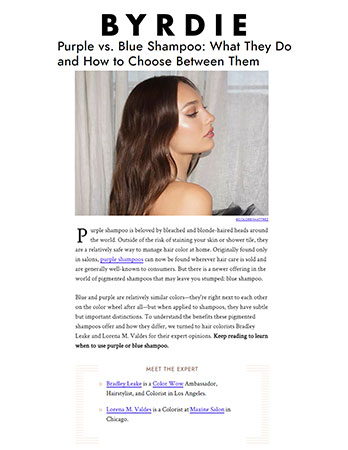Byrdie May 12, 2023
BYRDIE
Hair
Purple vs. Blue Shampoo: What They Do and How to Choose Between Them
Purple shampoo is beloved by bleached and blonde-haired heads around the world. Outside of the risk of staining your skin or shower tile, they are a relatively safe way to manage hair color at home. Originally found only in salons, purple shampoos can now be found wherever hair care is sold and are generally well-known to consumers. But there is a newer offering in the world of pigmented shampoos that may leave you stumped: blue shampoo.
Blue and purple are relatively similar colors—they're right next to each other on the color wheel after all—but when applied to shampoos, they have subtle but important distinctions. To understand the benefits these pigmented shampoos offer and how they differ, we turned to hair colorists Bradley Leake and Lorena M. Valdes for their expert opinions. Keep reading to learn when to use purple or blue shampoo.
MEET THE EXPERT
Bradley Leake is a Color Wow Ambassador, Hairstylist, and Colorist in Los Angeles.
Lorena M. Valdes is a Colorist at Maxine Salon in Chicago.
Purple vs. Blue Shampoo
The difference between blue and purple shampoos lies in which colors they neutralize: Purple neutralizes yellow while blue neutralizes orange and brassy tones. "This is because violet-purple is across the wheel from yellow, and blue is across the wheel from orange," says Valdes. "The different color shampoos focus on different tones in your hair that occur after bleaching or lightening," adds Leake.
"These shampoos have the same effect on different shades of hair. Basically, purple is to blonde as blue is to brunette," explains Leake. Valdes agrees, sharing that blue shampoo can especially benefit brunettes without any bleaching or highlights. For this reason, blue shampoo would be an ideal option for someone with reddish-brown hair looking to achieve a cooler tone without dying their hair darker.
Both shampoos can help extend your time between colorings, too. "Working a blue or purple shampoo into your routine can extend the life of your color between salon visits and promote healthier, fresher, more natural-looking hair," shares Leake. If you have not experienced much growth since your last salon visit, but your hair tone has changed, a blue or purple shampoo could help tide you over until your next appointment.
What Is Purple Shampoo?
Purple shampoo is a term used to describe purple color-depositing shampoo. It is formulated with violet-colored molecules that combat unwanted yellow tones in blonde hair, explains Leake. It works by utilizing color theory similar to color-correcting makeup, minimizing unwanted discoloration by neutralizing it with the color opposite to it on the color wheel.1 Since violet, or purple, is the opposite of yellow on the color wheel, Valdes explains that purple shampoo deposits some purple pigment while you wash your hair. This helps to neutralize brass in yellow/blonde hair colors.
Those who bleach their hair often experience unwanted yellow tones in their hair in the weeks following a salon visit. The reasons for yellow undertones vary, but often it has to do with the melanin in the hair interacting with the bleach used to lighten it.2 This can then be exacerbated by factors such as sun exposure and water quality.
What Is Blue Shampoo?
Blue color-depositing shampoos can be helpful to neutralize more orange or bright brassy tones in the hair. (Blue is opposite to orange on the color wheel.) "Blue shampoo is designed to combat brassy tones in brunette hair by depositing blue-violet pigments that neutralize unwanted orange tones," explains Leake.
But blue shampoo is not only beneficial to brunettes. Valdes adds that blue-depositing shampoo is used to help neutralize yellow hair with a slight orange or brassy undertone, too. "It will also help neutralize hair oxidation for a cooler or ashier tone [without leaving] a slight pearl or purple tone," she says, adding that blue shampoos can benefit those with salt-and-pepper colored hair, too.
Which One Is Right for Your Hair?
"If you have blonde hair, you more likely want purple shampoo, and any darker or brunette shades will most likely require blue," Leake explains.
If your hair is highlighted or somewhere between blonde and brunette, Leake recommends inspecting the tone you want to remove and determining if it's more yellow or orange. "Blondes may fade into an unnatural yellow color, a problem easily solved by purple shampoo," he says. "Brunettes that opt for a balayage or highlighted look will often lose their shine to brassy orange tones, which can be stopped by blue shampoo. I also love to use the Color Wow's Color Control Toning + Styling Foam ($24) as a quick and easy alternative that neutralizes brassy tones instantly."
If you're uncertain about which color shampoo to go with, Valdes offers this helpful guide based on the discoloration you observe in your hair:
Seeing mostly yellow tones: purple shampoo
Seeing yellow/orange tones: blue shampoo
Salt and pepper hair: blue shampoo
Brunettes (without blonde highlights): blue shampoo
No matter what color shampoo you choose, it is important to avoid over-use, cautions Valdes. "It's always best to mix your purple or blue shampoo with your regular shampoo to help dilute how strong the product is," she says, adding that this dilution can help to avoid over-depositing and dryness from the pigment-depositing shampoos.
The Final Takeaway
Purple and blue shampoos are at-home tools for battling discoloration between salon visits. Both shampoos utilize color theory to banish brassy tones, but the choice of which to use depends on whether you're experiencing more yellow or orange hues in your hair. By neutralizing unwanted yellow or orange tones, blue and purple shampoos can help you achieve or maintain your desired shade.

